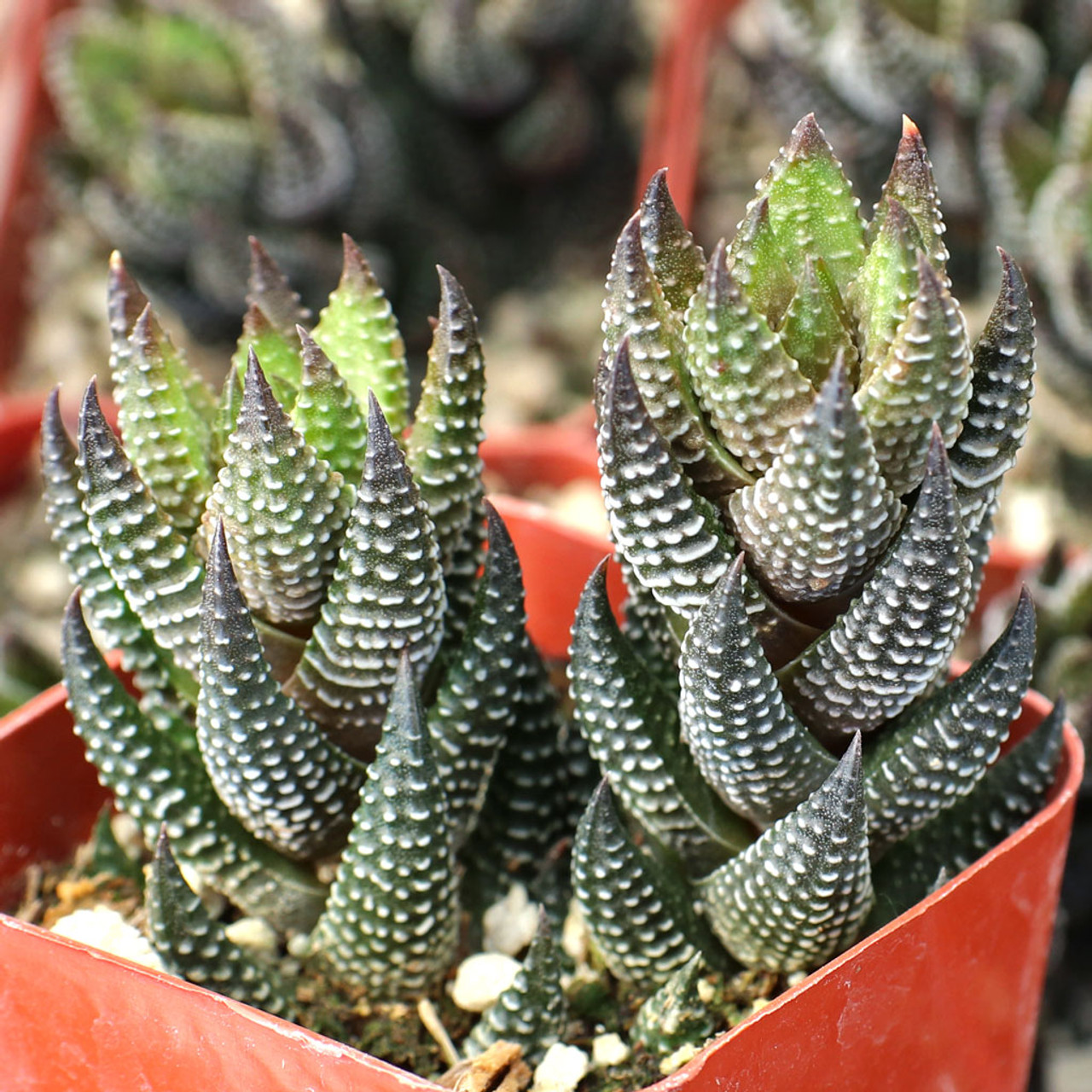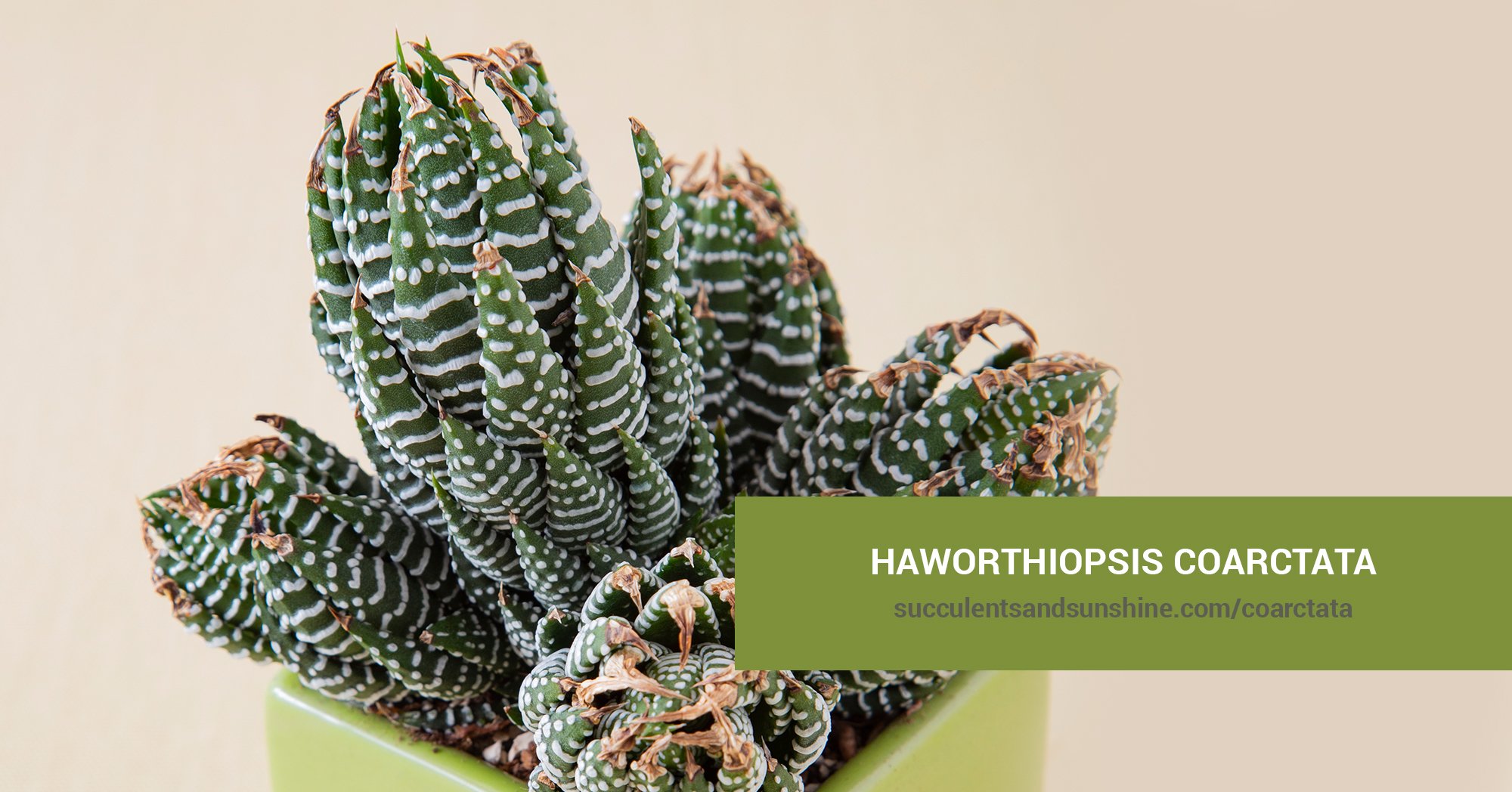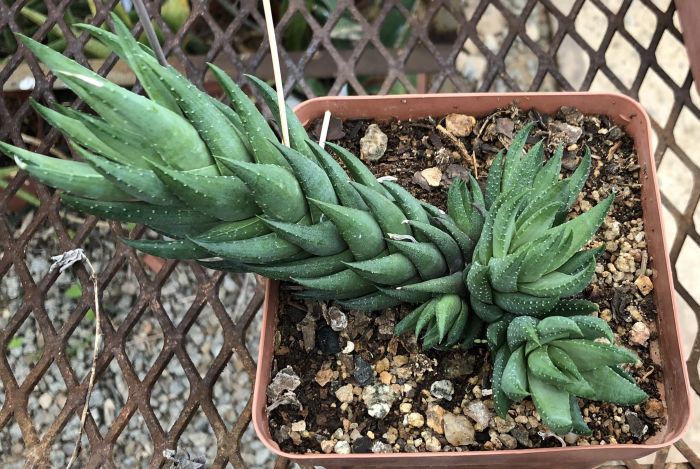This succulent grows slowly in clumps and has dark green leaves with white stripes. When exposed to extreme sunlight or cold temperatures, the leaves take on a pink to purple hue. Its long stems are topped with short, curved leaves.
Table of Contents
Care and Propagation Information
Haworthiopsis coarctata is an ideal choice for a rock garden. It provides beautiful greenery and in the summertime, you can expect to see small green blooms. This succulent is a great addition for filling out an arrangement.
Watering
Haworthiopsis coarctata should be watered using the “soak and dry” technique, allowing the soil to become completely dry before providing more water.
Where to Plant
Haworthiopsis coarctata is not suited for cold temperatures, so if you live in a climate with temperatures that dip below 0° F (-1.1° C), it is advisable to place it in a pot that can be brought inside when necessary. This succulent thrives in full or partial sunlight, so choose a spot in your garden that receives at least 6 hours of light every day.
Commonly Mistaken For
The leaves of Haworthiopsis coarctata are more compact, wider, and smoother than those of Haworthia reinwardtii.
How to Propagate Haworthiopsis coarctata
Offsets
Haworthiopsis coarctata will generate miniature offsets around the bottom of the plant. Detach these offsets and let them dry out for one to two days ahead of replanting them.
Leaves
Plant the leaf in a shallow container filled with soil and sand. Keep the soil moist, but not wet, and place the container in a bright spot with indirect sunlight. In time, the leaf will begin to sprout new roots and leaves.
To propagate Haworthiopsis coarctata, select a firm and healthy leaf and twist it off the stem. It is okay if some of the stem is still attached to the leaf. Put the leaf in a shallow container containing soil and sand, and keep the soil moist but not wet. Place the container in an area that gets bright indirect sunlight. Roots and leaves will eventually begin to sprout from the leaf.
Wait several days for the leaf to form a callus, then place it on well-draining soil. Make sure to keep the soil moist by watering it whenever the top layer has dried out. Once the leaf has sprouted roots, a rosette of new growth has appeared, and the old leaf has withered away, it can be planted in a new pot.
Seeds
If you are starting Haworthiopsis from seed, you should plant it in a soil that drains well in the autumn. If you live in a climate with a hardiness zone of 9a or higher, you can sow the seeds outside. For cooler climates, you might need to start the seeds indoors under a grow light.
Care and Propagation Information
General Care for Haworthiopsis coarctata
Haworthiopsis coarctata is an ideal choice for a rock garden. It provides beautiful greenery and in the summertime, you can expect to see small green blooms. This succulent is a great addition for filling out an arrangement.
Watering
Haworthiopsis coarctata should be watered using the “soak and dry” technique, allowing the soil to become completely dry before providing more water.
Where to Plant
Haworthiopsis coarctata is not suited for cold temperatures, so if you live in a climate with temperatures that dip below 0° F (-1.1° C), it is advisable to place it in a pot that can be brought inside when necessary. This succulent thrives in full or partial sunlight, so choose a spot in your garden that receives at least 6 hours of light every day.
Commonly Mistaken For
The leaves of Haworthiopsis coarctata are more compact, wider, and smoother than those of Haworthia reinwardtii.
How to Propagate Haworthiopsis coarctata
Haworthiopsis coarctata is known to reproduce quickly and easily, producing numerous offsets. It can also be propagated through sowing of seeds or through the use of leaves.
Offsets
Haworthiopsis coarctata will generate miniature offsets around the bottom of the plant. Detach these offsets and let them dry out for one to two days ahead of replanting them.
Leaves
Plant the leaf in a shallow container filled with soil and sand. Keep the soil moist, but not wet, and place the container in a bright spot with indirect sunlight. In time, the leaf will begin to sprout new roots and leaves.
To propagate Haworthiopsis coarctata, select a firm and healthy leaf and twist it off the stem. It is okay if some of the stem is still attached to the leaf. Put the leaf in a shallow container containing soil and sand, and keep the soil moist but not wet. Place the container in an area that gets bright indirect sunlight. Roots and leaves will eventually begin to sprout from the leaf.
Wait several days for the leaf to form a callus, then place it on well-draining soil. Make sure to keep the soil moist by watering it whenever the top layer has dried out. Once the leaf has sprouted roots, a rosette of new growth has appeared, and the old leaf has withered away, it can be planted in a new pot.
Seeds
If you are starting Haworthiopsis from seed, you should plant it in a soil that drains well in the autumn. If you live in a climate with a hardiness zone of 9a or higher, you can sow the seeds outside. For cooler climates, you might need to start the seeds indoors under a grow light.
FAQ
What is Haworthia coarctata used for?
Haworthiopsis coarctata is an ideal choice for a rock garden. It provides an attractive backdrop to other succulents and produces bright green blossoms in the summer months.
Are Haworthia toxic to humans?
Haworthia are not hazardous or harmful if ingested, similar to Sempervivum Hens and Chicks, which have the same non-toxic qualities.
How big does Haworthia coarctata grow?
Haworthiopsis coarctata has long stems that become larger with age, and the leaves on these stems are strong and juicy and have white, shiny warts or stripes. This plant can grow anywhere from 50 mm to 200 mm tall, and mature rosettes of leaves can reach up to 300 mm in length.
How do you grow Haworthia coarctata?
Haworthiopsis coarctata is not tolerant of cold temperatures, so if your area experiences temperatures below 0° F (-1.1° C), it is best to plant it in a pot that can be moved indoors. This succulent enjoys full sun to partial sun, so be sure to place it in your garden in an area that receives at least 6 hours of sunlight per day.



